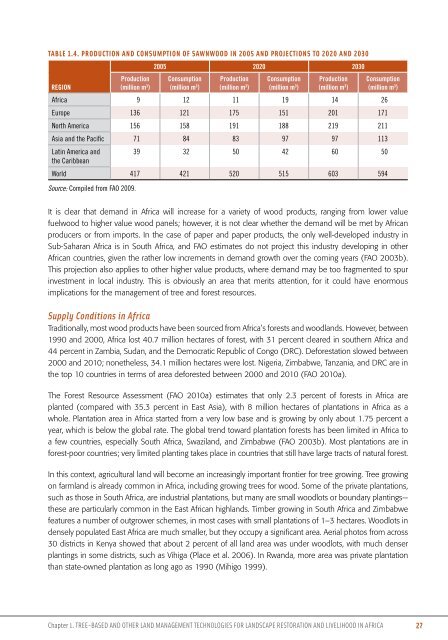INVESTING IN TREES AND LANDSCAPE ... - PROFOR
INVESTING IN TREES AND LANDSCAPE ... - PROFOR
INVESTING IN TREES AND LANDSCAPE ... - PROFOR
You also want an ePaper? Increase the reach of your titles
YUMPU automatically turns print PDFs into web optimized ePapers that Google loves.
TABLE 1.4. PRODUCTION <strong>AND</strong> CONSUMPTION OF SAWNWOOD <strong>IN</strong> 2005 <strong>AND</strong> PROJECTIONS TO 2020 <strong>AND</strong> 2030<br />
REGION<br />
Production<br />
(million m 3 )<br />
2005 2020 2030<br />
Consumption<br />
(million m 3 )<br />
Production<br />
(million m 3 )<br />
Consumption<br />
(million m 3 )<br />
Production<br />
(million m 3 )<br />
Consumption<br />
(million m 3 )<br />
Africa 9 12 11 19 14 26<br />
Europe 136 121 175 151 201 171<br />
North America 156 158 191 188 219 211<br />
Asia and the Pacific 71 84 83 97 97 113<br />
Latin America and 39 32 50 42 60 50<br />
the Caribbean<br />
World 417 421 520 515 603 594<br />
Source: Compiled from FAO 2009.<br />
It is clear that demand in Africa will increase for a variety of wood products, ranging from lower value<br />
fuelwood to higher value wood panels; however, it is not clear whether the demand will be met by African<br />
producers or from imports. In the case of paper and paper products, the only well-developed industry in<br />
Sub-Saharan Africa is in South Africa, and FAO estimates do not project this industry developing in other<br />
African countries, given the rather low increments in demand growth over the coming years (FAO 2003b).<br />
This projection also applies to other higher value products, where demand may be too fragmented to spur<br />
investment in local industry. This is obviously an area that merits attention, for it could have enormous<br />
implications for the management of tree and forest resources.<br />
Supply Conditions in Africa<br />
Traditionally, most wood products have been sourced from Africa’s forests and woodlands. However, between<br />
1990 and 2000, Africa lost 40.7 million hectares of forest, with 31 percent cleared in southern Africa and<br />
44 percent in Zambia, Sudan, and the Democratic Republic of Congo (DRC). Deforestation slowed between<br />
2000 and 2010; nonetheless, 34.1 million hectares were lost. Nigeria, Zimbabwe, Tanzania, and DRC are in<br />
the top 10 countries in terms of area deforested between 2000 and 2010 (FAO 2010a).<br />
The Forest Resource Assessment (FAO 2010a) estimates that only 2.3 percent of forests in Africa are<br />
planted (compared with 35.3 percent in East Asia), with 8 million hectares of plantations in Africa as a<br />
whole. Plantation area in Africa started from a very low base and is growing by only about 1.75 percent a<br />
year, which is below the global rate. The global trend toward plantation forests has been limited in Africa to<br />
a few countries, especially South Africa, Swaziland, and Zimbabwe (FAO 2003b). Most plantations are in<br />
forest-poor countries; very limited planting takes place in countries that still have large tracts of natural forest.<br />
In this context, agricultural land will become an increasingly important frontier for tree growing. Tree growing<br />
on farmland is already common in Africa, including growing trees for wood. Some of the private plantations,<br />
such as those in South Africa, are industrial plantations, but many are small woodlots or boundary plantings—<br />
these are particularly common in the East African highlands. Timber growing in South Africa and Zimbabwe<br />
features a number of outgrower schemes, in most cases with small plantations of 1–3 hectares. Woodlots in<br />
densely populated East Africa are much smaller, but they occupy a significant area. Aerial photos from across<br />
30 districts in Kenya showed that about 2 percent of all land area was under woodlots, with much denser<br />
plantings in some districts, such as Vihiga (Place et al. 2006). In Rwanda, more area was private plantation<br />
than state-owned plantation as long ago as 1990 (Mihigo 1999).<br />
Chapter 1. TREE-BASED <strong>AND</strong> OTHER L<strong>AND</strong> MANAGEMENT TECHNOLOGIES FOR L<strong>AND</strong>SCAPE RESTORATION <strong>AND</strong> LIVELIHOOD <strong>IN</strong> AFRICA<br />
27

















